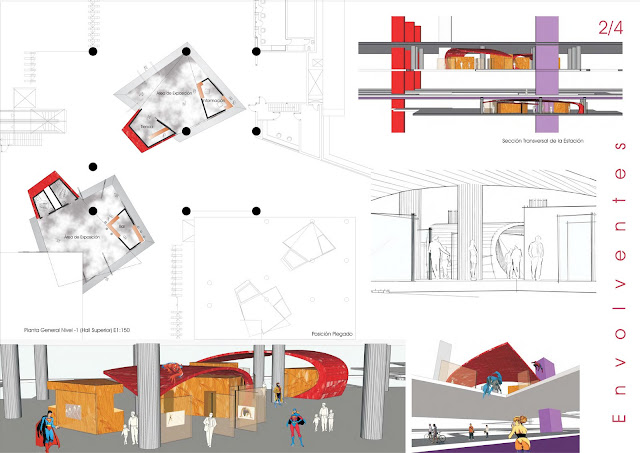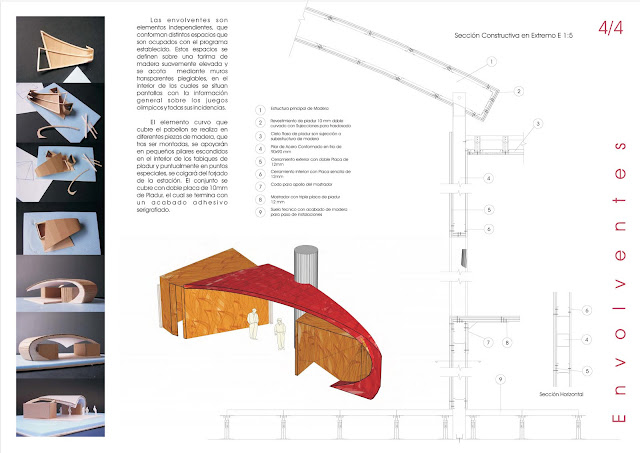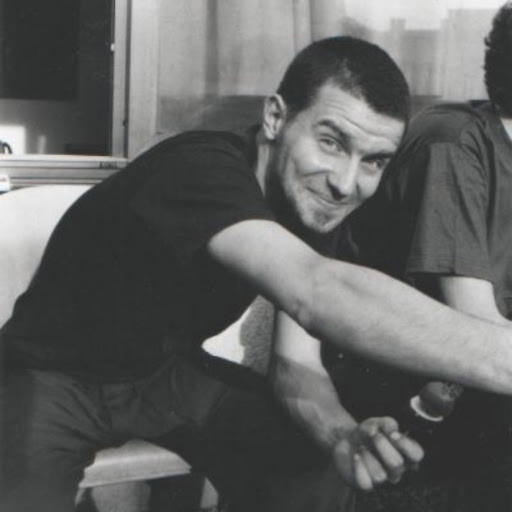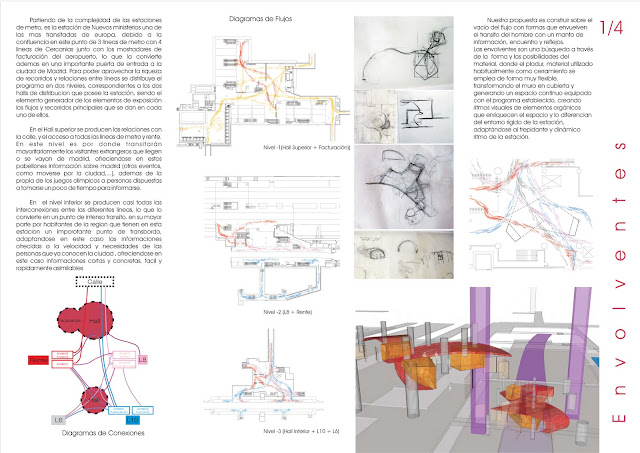 Partiendo de la complejidad de las estaciones de metro, es la estación de Nuevos ministerios una de las mas transitadas de Europa, debido a la confluencia en este punto de 3 líneas de metro con 4 líneas de Cercanías junto con los mostradores de facturación del aeropuerto, lo que la convierte además en una importante puerta de entrada a la ciudad de Madrid. Para poder aprovechar la riqueza de recorridos y relaciones entre líneas se distribuye el programa en dos niveles, correspondientes a los dos vestibulos de distribución que posee la estación, siendo el elemento generador de los elementos de exposición los flujos y recorridos principales que se dan en cada uno de ellos.
Partiendo de la complejidad de las estaciones de metro, es la estación de Nuevos ministerios una de las mas transitadas de Europa, debido a la confluencia en este punto de 3 líneas de metro con 4 líneas de Cercanías junto con los mostradores de facturación del aeropuerto, lo que la convierte además en una importante puerta de entrada a la ciudad de Madrid. Para poder aprovechar la riqueza de recorridos y relaciones entre líneas se distribuye el programa en dos niveles, correspondientes a los dos vestibulos de distribución que posee la estación, siendo el elemento generador de los elementos de exposición los flujos y recorridos principales que se dan en cada uno de ellos.
En el hall superior se producen las relaciones con la calle, y el acceso a todas las líneas de metro y RENFE. En este nivel es por donde transitarán mayoritariamente los visitantes extranjeros que lleguen o se vayan de Madrid, ofreciéndose en estos pabellones información sobre Madrid (otros eventos, como moverse por la ciudad,...), además de la propia de los juegos olímpicos a personas dispuestas a tomarse un poco de tiempo para informarse.
En el nivel inferior se producen casi todas las interconexiones entre las diferentes líneas, lo que lo convierte en un punto de intenso transito, en su mayor parte por habitantes de la región que tienen en esta estación un importante punto de trasbordo, adaptándose en este caso las informaciones ofrecidas a la velocidad y necesidades de las personas que ya conocen la ciudad, ofreciéndose en este caso informaciones cortas y concretas, fácil y rápidamente asimilables.
Nuestra propuesta es construir sobre el vacío del flujo con formas que envuelven el transito del hombre con un manto de información, encuentro y reflejos. Las envolventes son una búsqueda a través de la forma y las posibilidades del material, donde el pladur, material utilizado habitualmente como cerramiento se emplea de forma muy flexible, transformando el muro en cubierta y generando un espacio continuo equipado con el programa establecido, creando ritmos visuales de elementos orgánicos que enriquecen el espacio y lo diferencian del entorno rígido de la estación, adaptándose al trepidante y dinámico ritmo de la estación.
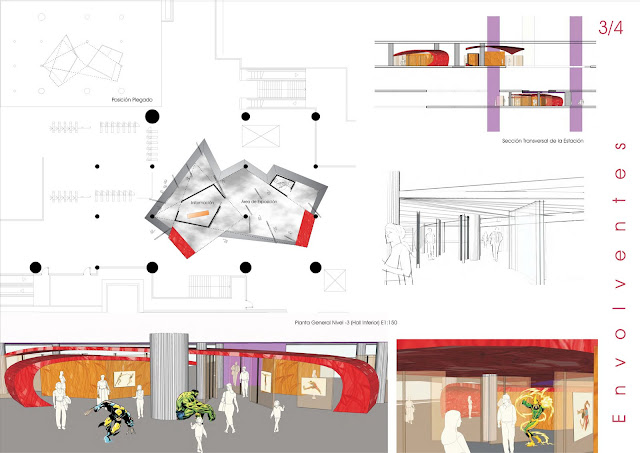
Departing from the complexity of subway stations, it is the station of Nuevos Ministerios one of the more travelled of Europe, due to the confluence in this point of 3 subway lines with 4 railway lines, together with the check-in desks of the airport, which turns it into an important door of entry to the city of Madrid. To be able to take advantage of the tours richness and relations between subway and railway lines, the program is distributed in two levels, correspondents to both foyers of distribution that the station have, getting the flows and principlal tours the generating reason of the exhibition points.
In the top hall take place the relation to the street and the distribution of the flows to the different subway and railway lines. In this level it is where there will pass most of the foreign visitors who come or go away of Madrid, offering them in these info points information about Madrid besides the proper one of the Olympic Games candidature to persons ready to take little time to be informed.
In the low level are the direc connections between the different lines, which turns it into a point of intense traffic, specially for inhabitants of the region who have on this station an important point of transfer, adapting in this case the information offered to the speed and needs of the persons who already know the city, offering them in this case short and concrete information, easy and fast to assimilate.
Our offer is to construct on the emptiness of the flow with forms that wrap the traffic of people with a mantle of information, meeting and reflections. The shapes are a search across the form and the possibilities of the material, where the pladur, material used habitually as skin, get used in a very flexible way, transforming the wall into cover and generating a constant space equipped with the established program, creating visual rhythms with organic elements that enrich the space and separate it from the rigid environment of the station, adapting to the trepidant and dynamic rhythm of the station.
Download PDF|A2|7.1Mb
